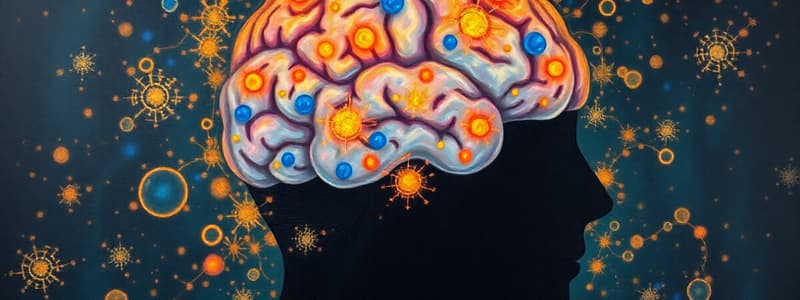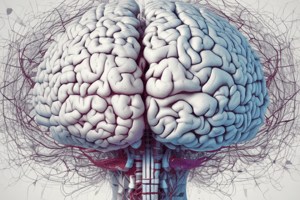Podcast
Questions and Answers
Which brain structure is primarily responsible for regulating crucial survival behaviors such as feeding, mating, and stress responses?
Which brain structure is primarily responsible for regulating crucial survival behaviors such as feeding, mating, and stress responses?
- Hypothalamus (correct)
- Amygdala
- Hippocampus
- Thalamus
What is the main function of the myelin sheath that surrounds the axon of a neuron?
What is the main function of the myelin sheath that surrounds the axon of a neuron?
- To contain neurotransmitters for communication
- To provide nutrients to the neuron
- To speed up signal transmission along the axon (correct)
- To receive incoming signals from other neurons
Which of the following best describes the role of the reticular activating system?
Which of the following best describes the role of the reticular activating system?
- Processing auditory and visual information
- Regulating motor coordination and balance
- Controlling consciousness, attention, and cardiorespiratory function (correct)
- Managing emotion and memory
Within the neuron, what is the primary function of the dendrites?
Within the neuron, what is the primary function of the dendrites?
Which lobe of the cerebral cortex is primarily involved in processing sensory information such as touch, pain, and spatial relationships?
Which lobe of the cerebral cortex is primarily involved in processing sensory information such as touch, pain, and spatial relationships?
What is the function of synaptic terminals (buttons) in neuronal communication?
What is the function of synaptic terminals (buttons) in neuronal communication?
The cerebellum plays a crucial role in which of the following functions?
The cerebellum plays a crucial role in which of the following functions?
What is the electrical charge of a neuron at its resting potential?
What is the electrical charge of a neuron at its resting potential?
Flashcards
Medulla Oblongata
Medulla Oblongata
The brain's control center for vital functions like breathing and heart rate, located at the base of the brain.
Occipital Lobe
Occipital Lobe
The part of the brain responsible for processing visual information, located at the back of the brain.
Parietal Lobe
Parietal Lobe
The part of the brain that processes sensory input like touch and pain, located at the top middle of the brain.
Frontal Lobe
Frontal Lobe
Signup and view all the flashcards
Axon
Axon
Signup and view all the flashcards
Synapse
Synapse
Signup and view all the flashcards
Graded Potential
Graded Potential
Signup and view all the flashcards
Resting Potential
Resting Potential
Signup and view all the flashcards
Study Notes
Cognitive Neuroscience
- This is the study of how cognition happens in the brain, focusing on the neural processes behind thoughts, memory, attention, and perception.
Regions of the Brain (Forebrain)
- Located at the top/front of the brain
- Responsible for processing sensory information, higher-level thinking, language, and motor functions.
- Diencephalon: Includes the thalamus and hypothalamus
- Telencephalon: Contains the cerebral cortex and limbic system.
- Limbic System: Controls emotion, motivation, memory, and learning.
- Amygdala: Processes emotions like fear and anger
- Hippocampus: Important for forming memories, especially spatial memories.
- Hypothalamus: Regulates behaviors like feeding, mating, and stress responses.
- Thalamus: A relay station for sensory information.
Regions of the Brain (Midbrain)
- Located within the brainstem
- Controls eye movements and processes auditory and visual information
Reticular Activating System
- Controls consciousness, attention, and cardiorespiratory function.
Regions of the Brain (Hindbrain)
- Located at the back/base of the brain
- Coordinates vital functions: breathing and motor activity.
- Cerebellum: Controls balance, coordination, and muscle tone.
- Pons: Involved in sleep and arousal.
- Medulla Oblongata: Manages cardiorespiratory function and reflex actions.
Lobes of the Cerebral Cortex
- Frontal Lobe: Associated with motor processing, problem-solving, planning, and judgment.
- Parietal Lobe: Processes sensory input like touch, pain, and spatial relationships.
- Temporal Lobe: Responsible for auditory processing and language comprehension.
- Occipital Lobe: Processes visual information.
Neuron Structure
- Basic unit of the nervous system: transmits signals via electrical and chemical processes.
- Cell Body (Soma): Contains the nucleus and provides nourishment to the neuron.
- Dendrites: Branch-like extensions that receive incoming signals.
- Axon: Long fiber that transmits signals to other neurons or muscles.
- Myelin Sheath: Insulating layer that speeds up signal transmission.
- Synaptic Terminals (Buttons): Contain neurotransmitters for communication.
Nerve Impulse Transmission
- Resting Potential: Neuron's stable, negative charge (-70mV) at rest.
- Graded Potential: Initial, localized electrical signals generated by stimulation.
- Action Potential: An all-or-nothing response transmitting the nerve impulse.
- Communication Between Neurons occurs at the synapse, where neurotransmitters cross the synaptic cleft to bind with receptors on the next neuron.
Neurotransmitters (Types and Function)
- Dopamine: Involved in reward, motivation, and motor control.
- Serotonin: Regulates mood, appetite, and sleep.
- Acetylcholine: Critical for muscle action, memory, and learning.
- Norepinephrine: Enhances alertness and focus.
- GABA: Inhibitory neurotransmitter that reduces neural excitability.
- Glutamate: Excitatory neurotransmitter that is critical for learning and memory.
- Parietal-Frontal Integration Theory (P-FIT): Highlights the interconnected regions, including the prefrontal cortex and parietal lobes, important for determining intelligence.
Studying That Suits You
Use AI to generate personalized quizzes and flashcards to suit your learning preferences.




